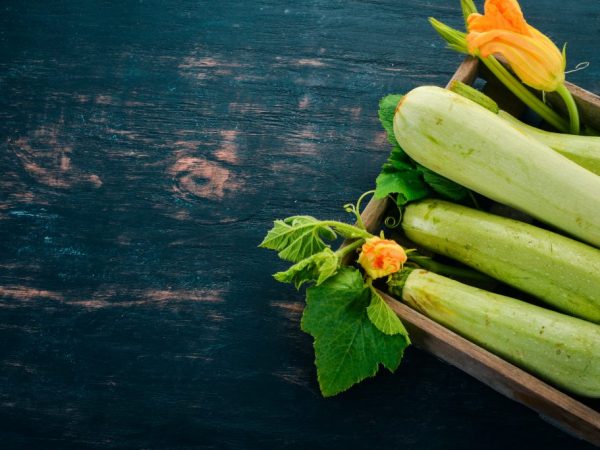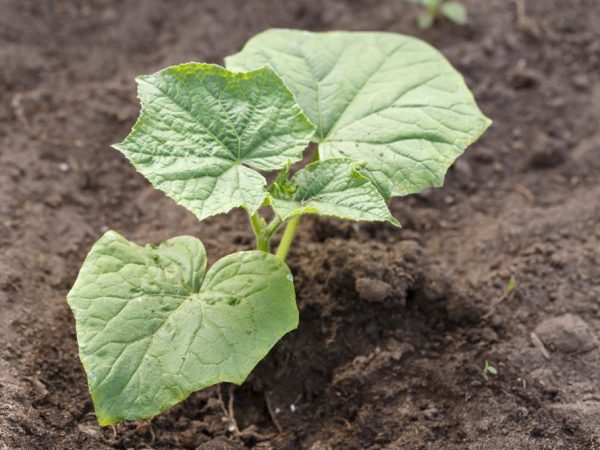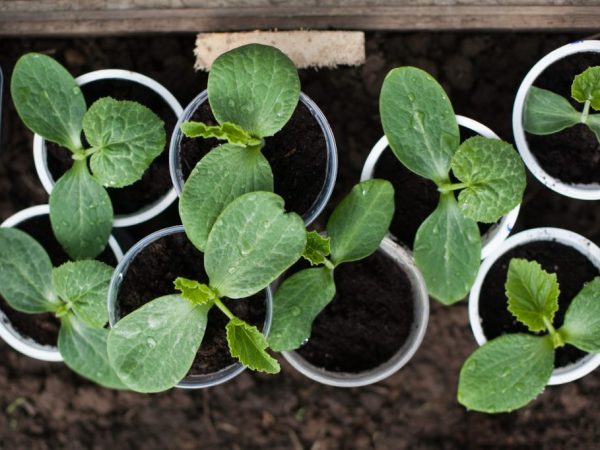Zucchini variety Iskander F1
Iskander Dutch marrow is one of the most popular. The vegetable is popular due to several qualities: high yield, early maturity, frost resistance and excellent fruit taste.

Zucchini variety Iskander F1
Features of the variety
For the first time this variety appeared on the territory of the Krasnodar Territory, later it began to be successfully grown in other regions of Russia.
The fruits have the following characteristics:
- the skin is light green in color, contains small inclusions;
- in mature vegetables, the skin is thin, easily removed with a knife;
- there is a small waxy coating on the surface of the fruit;
- vegetables have the shape of a cylinder; when fully ripe, they reach 500-600 g.
The main advantages of F1 zucchini include the following:
- high yield - with good care and favorable weather, it will be possible to remove up to 17 kg of tasty and juicy vegetables from one plant;
- early maturity - the first harvest of vegetables is harvested within 1-1.5 months after planting the seeds;
- this is one of the few varieties that easily tolerates a drop in temperature and bears fruit even in cold weather;
- the plant is unpretentious in care;
- has excellent taste.
The only drawback of the Iskander F1 variety is that the fruits are not stored for long.
Growing features
It will be possible to grow this vegetable in two ways - seedling and direct planting of seeds in open ground. Seeds must be pre-prepared.
Seed treatment
For successful germination, the seeds are soaked in warm water, adding useful trace elements for vegetable crops. The optimum water temperature for soaking is 20 ° C.
After soaking for several hours, the seeds are wrapped in a damp cloth and kept at room temperature (23-25 ° C). It is important that the fabric does not dry out, otherwise the seeds will not sprout. It is irrigated periodically from a spray bottle. Some gardeners use a different method of seed preparation: they place the seed in the refrigerator for 15 hours. This is followed by a warm-up procedure at a temperature of 23-24 ° C. These manipulations are repeated until the seeds hatch.
Iskander zucchini is a hybrid, so the seeds of the grown fruits are not suitable for planting next year.
Soil requirements

Sour soil is not suitable for zucchini.
The preparation of the site for planting the Iskander F1 zucchini variety is carried out in the fall: the soil is dug up, fertilized, and with the arrival of spring, it is loosened and leveled. It is required to use the site without soil acidification, because in acidic soil, zucchini will grow poorly and bear fruit. Dolomite flour, powdered chalk or hydrated lime are added to the soil.
For good yields and preventing the appearance of parasites, it is necessary to follow the rules of crop rotation, therefore, the area on which pumpkin crops grew last year is not suitable for growing zucchini. Suitable precursors are carrots, onions, potatoes, tomatoes, cabbage and herbs.
Seedling method
Planting seeds in disposable cups is carried out in the second decade of April. The containers are filled with loose nutrient soil. Garden soil should be mixed with sand, compost or last year's manure in a 5: 1: 1 ratio.
Depressions are made in the cups (2-3 cm), then seeds are placed in them. They are sprinkled with soil and watered with warm, settled water. One plant consumes 0.5 liters of water.
Features of seedling care
Crop care is as follows:
- Until the seeds germinate, the crops are covered and left in a warm, sunny place, ensuring a stable temperature within 20-25 ° C. After the sprouts have hatched through the soil, the temperature is lowered to 15-20 ° С during the day and up to 12-15 ° С at night. In such conditions, the sprouts are kept for 5 days. Then the temperature is increased to 18-23 ° C in the daytime, and at night it is lowered to 14-17 ° C. This temperature regime is observed until the plant is transplanted to the garden bed.
- Sprout should be watered regularly and only with warm, settled water. For 7-8 plants, 1 liter of water is consumed, the frequency of watering is once every 5 days.
- As soon as the first shoots appear, which happens in about a week, the crops are fed with a urea solution (0.5 tsp of the substance per 1 liter of water). 200 ml of working solution is consumed per plant. A week later, make another top dressing using a nitrophosphate (1 tsp substance is dissolved in 1 liter of water). A glass of liquid fertilizer is poured under one seedling.
Providing these conditions, a person will be able to get strong and healthy seedlings for further cultivation in the open field.
Transfer to the garden

The plant can be replanted when the third leaf appears.
Plants are transplanted to the garden bed at the stage of the appearance of the third leaf. This procedure is performed in late May or early June. For planting, it is better to use a steam bed or heap.
On the fertilized and loosened area, the holes are placed at a distance of 60 cm from each other, watered with warm water and the germinated seedlings are lowered into them to a depth of 2-3 cm.Then the plants are sprinkled with earth, lightly pressed and watered again.
For an earlier planting of seedlings on the site (at the beginning or in the middle of April), a shelter should be built in advance from a metal frame and film. At night, the crops are covered with material.
Landing in open ground
The optimal time for planting seeds in open ground is the last decade of May or the first decade of June. By this time, the soil will warm up to the desired temperature of 10-12 ° C. Despite the fact that this plant tolerates cold well, seeds are planted in a calm and sunny place for rapid germination and growth.
The seeds are deepened into prepared grooves at a distance of 60 cm from each other. Planting seeds is required with the sharp end down. Top crops are sprinkled with earth, watered with warm water. At night, it is better to cover them with a film or any non-woven material, because the air is cooler at night and can negatively affect the speed of seed germination.
Care
As the seedlings grow and develop, they thin out, removing elongated, thin and yellowed stems. Strong sprouts are planted in an empty place. Caring for zucchini is simple and consists of the following:
- Watering and loosening. The plantings are moistened as the soil dries. Up to 5 liters of water are poured under each bush. In a rainy summer, humidification is carried out no more than once a week or less often. Waterlogging of the bushes can lead to decay of the root system and the death of plants. After watering, the soil is mulched, then surface loosening is performed so as not to damage the plant roots located close to the soil surface.
- Top dressing. For the entire season of growing marrow Iskander F1 needs to be fed three times. When two pairs of leaves appear, ammonium and potassium nitrate (20 g of each component) and 40 g of superphosphate are added under the bushes. The dry mixture is dissolved in a bucket of water.Also, as the first feeding, a mullein solution is suitable, for 20 liters of water there is 1 liter of substance. At the stage of ovary formation, marrow is fertilized with potassium nitrate and superphosphate - 50 g of each substance per bucket of water. Re-feeding is applied during the fruiting period, which increases the productivity of the bushes and the quality of the fruits.
Prophylaxis
This culture rarely gets sick and does not suffer from parasites, infection is possible only in case of improper care and non-compliance with the rules of crop rotation. When fighting diseases such as gray rot, powdery mildew and anthracnose, Bordeaux mixture or copper sulfate is used. For the extermination of parasites (spider mites, aphids, whiteflies), insecticides are used: "Actellik", "Confidor", "Aktara" or "Fundazol".
Collection and storage
The first collection of Iskander F1 zucchini is carried out in the first decade of June. The maturity of vegetables is determined by sound. This requires knocking on the surface. If the sound is dull, the vegetables are cut. A hard skin that is difficult to remove with a knife is also a sign of the maturity of the vegetables.
It is allowed to store the fruits for about 5 months, if you create the necessary conditions for them. Store in a cool, dark place with low humidity. If the year turned out to be fruitful, they make preparations for the winter from vegetables.
Conclusion
Almost all gardeners who are engaged in the cultivation of this vegetable are satisfied with both the quantity and quality of the crop. Iskander F1 squash is very popular in modern gardening due to its high yield, unpretentious care and excellent fruit taste.

